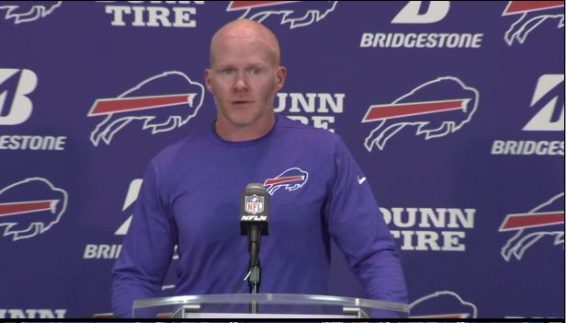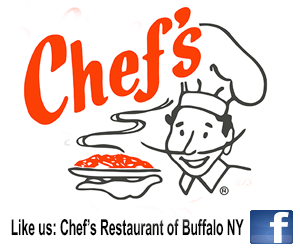Buffalo Bills Head Coach Sean McDermott
Monday, November 20, 2017
Opening Statement: Okay, we’ll go ahead and open it up to questions.
Q: Have you settled on a starting quarterback for next week?
A: Still evaluating right now. I understand where you’re coming from on that. Still evaluating, and [we’ll] take it one day at a time right now.
Q: Given some of the player’s comments this week that they were waiting until Wednesday to hear about a quarterback, how much does that weigh into your decision on when to make this decision about the quarterback?
A: You’re saying how much–
Q: Players seem to be caught off guard that it happened on a Wednesday morning, instead of earlier in the week this past week. How much does that weigh into when you make the decision on a starter this week?
A: Right, well last week it happened on a Tuesday, when I gave the quarterbacks notice. I do think about our team in everything I do. This decision, other decisions, I think heavily about our team in every decision we make.
Q: Nathan Peterman played poorly, to continue on with a player who had five interceptions in the first half, what message might that send to the team do you wonder?
A: Well let me start off here with Nathan; one game is not going to define Nathan or Nathan’s career. Young players go through it, and you saw some of it yesterday. I put that back on myself. I own the decision. Still, as I said yesterday, I don’t regret the decision, I regret the result. There’s other hands also in the result. It’s never about one player. I’m confident in Nathan, and his mental toughness. We move forward, we learn, we grow from it, and we get better.
Q: To that point, because we don’t see practice, we don’t seem him [Nathan Peterman] in the meetings, what specifically did you see from him that he was able to grow enough in that two and a half months to where you felt comfortable enough with starting him in that spot, at 5-4 in the playoff spot at that point?
A: That’s a fair question. I’m evaluating, like we do all players; Nathan, from the time he walked in the door, and really, before that. You watch how he handles himself intangibly, because that’s a big part of the quarterback position, are the intangibles; of all positions, let alone the quarterback position. You watched how he develops skill-wise, how he studied, how he prepared himself for the opponent, how he became familiar with more and more of NFL schemes, how he performed in practice and then the preseason games, and then the short sample of the [Saints] game the other week there. That was all part of his process as we continue to evaluate Nathan. I remain confident in Nathan. There are some plays yesterday I know he wants back. There were also some plays when you look at it, you say ‘that was pretty darn good’. [It was] hard to see, on the surface, 10,000 foot view, hard to see that with the result being what it was. When you take it one play at a time and you really look at it, you can say ‘hey, we’re moving the ball’. Sometimes you have to throw and you have to catch. But again, I won the decision and that’s on me.
Q: The critics out there will say that the decision for you to start Peterman backfired. Did it backfire?
A: Well sometimes you make decisions in leadership roles like this, that work out, and sometimes they don’t work out. I think the biggest thing is you try and make every decision with the right agenda, with the right decision-making process in mind, that leads you to the decision that you feel is right. That’s what I felt like in this case, and I stand by that decision. Obviously, it didn’t work out. You go back, you learn from it. I learned from it as a head coach, and I expect us all to learn from it, [that] we grow and move forward, as we continue to build.
Q: Can you continue to sell the idea that you’re trying to win now and plan for the future when you’re not even sure which quarterback is going to play?
A: Well we’re building. In building, this is part of the growth process. You go through these pains. It burns, it burns hard. You don’t want that result that we had yesterday. I’ve been on the other side of it too. Every decision we make is with the thought of winning now, yes, but also winning the future. That’s part of the vision for this organization.
Q: Not even looking at it like an emotional whether it hurts way, the way I’m saying it is that, if you come back with Tyrod [Taylor], then that’s a sign to me that you’re trying to win now, and he’d give you a better chance now; he’s more experienced, he’s had more games, more success. If you’re going with Nathan, then you’re looking more toward the future, it’s pretty clear to me. Am I wrong on that?
A: That’s your evaluation. I have to see it through my lenses.
Q: That’s what I’m asking for?
A: Both quarterbacks have their own abilities and own skill set. I’m always going to look at both. How best do we equip our team to win now, and also set ourselves up to build for a strong future? That’s part of that process, as I said earlier.
Q: You said there were some plays [from Peterman] that were pretty darn good, that were wild plays to you – maybe not wild plays, but ones that you can build on – can you point out some of those to us? What makes you feel optimistic about him going forward?
A: Well you go back and you look at the first drive. I think we started off with two runs, then we came out and threw, I believe, it was a play-action pass over the middle. I believe it was Kelvin’s [Benjamin] play in fact. He hit Kelvin right in stride, and it was tight coverage, he threw it into a tight window. This is a league of contested throws, contested balls, and you have to be able to do that, and he did it. Now there was a couple other instances also, but just to name one. We got into a rhythm early on the offensive side. I was pleased with that drive, up until the point where we had the interception. Things went downhill, but we came back the next drive, the running game got on track there [the next drive], and we scored the touchdown. There were positives in there, so there was growth. There was growth throughout our football team. I know on the surface, the result wasn’t there. When you look at [it], these guys played physical in all three phases. They played hard in all three phases. As we grow, as we develop, as we build, we’re developing a standard too, of how we do things. We’re developing a culture of how we do things and what it needs to look like. I get it, sometimes we’re not going to get the result we want. Sometimes there’s a lag effect, and I’ve talked about that before, as you build, and grow and develop things. That’s painful. That’s the way it’s been the last couple of weeks, I know that, I get it. I shoulder that responsibility.
Q: Will you meet with your leadership council regarding the quarterback decision?
A: You said will I?
Q: Will you meet with them, yes?
A: We’ll see. I’m first going to evaluate on my own, and then evaluate with our coaches. Then, there’s a progression. I always try to communicate with the leaders of this football team.
Q: Yesterday after the game, Tyrod said the leadership council meets with you, they talk about these things and said, ‘these are the things we’ll talk about,’ meaning if, clearly Tyrod’s position has impacted a bit, but how much do you weigh what they say in that meeting to you about this decision or about any big decision you make personnel-wise?
A: That’s a good question. I put a lot of stock into that. They carry a lot of weight. Obviously, I have the final say, and they respect that. They’ve done a phenomenal job with that to this point. They’re the guys, they’re on that council for a reason. They’re my sounding board on some things. I give them a lot of ownership into this team, and they’ve done a phenomenal job with that to this point.
Q: Can you give us an update on Kelvin and Micah [Hyde]?
A: Yeah, real quick on Kelvin, the good news is there is no ligament damage. We’re still under evaluation on the rest of it at this point. Then Micah, Micah checked out fine, he should be fine.
Q: What feedback did you get from ownership before you announced the quarterback move last week, and maybe what feedback did you get since the game yesterday?
A: From day one, Kim and Terry [Pegula] have given us everything we’ve asked for. They’ve supported us to the ‘nth’ degree, and in this case, no different. I made the decision, certainly communicated with Brandon [Beane] on it, like we do every move. Then, briefed Kim and Terry on it. So they’ve supported us from day one on all of our decisions, and they do a tremendous job of giving us the resources to win.
Q: What do you think it does to your credibility in the room when you put a guy in there in the middle of a playoff hunt, and you think he’s ready, then he plays the way he did? What do you think that does to your credibility with the guys?
A: At this point in the season, I hope with them, that I’ve built up enough credibility, trust. Then, there’s also a human element of it, that ‘hey, I’m trying to do what’s right,’ and not every decision is going to work out exactly like I wanted it to. You take responsibility, that’s what you do. You hope by doing that, that over time, you’re going to make more right decisions than you make that aren’t so right. But I am going to learn from it at the same time, and get better. Just like I expect them. They’re not always going to play one play that’s exactly right, but they’re going to learn from it, grow and get better. That’s also part of the growth process, that’s also part of building, and growing and becoming better.
Q: Along those lines, you mentioned that it was a calculated risk, and you were willing to step out on that ledge. How do you, the next time you’re going to make a decision like that, does it enter the back of your mind like how do you trust yourself to continue to not let your thought process be affected by the result?
A: That’s a fair question. [You] stay decisive, stay confident and be decisive. As a decision maker, when you waiver is when you get yourself in trouble. Obviously, listening to people, listening to opinions of people I trust, [and] communicating with people. Then also, when a decision needs to be made, be decisive and go with it.
Q: You guys have talked about since day one, building something that you can sustain. Is that still first and foremost what you’re trying to accomplish here? You’re in a playoff hunt with a lot of other teams, and yet there’s also something beyond the season.
A: You’re right. There’s certain things that we want to do. Yes, we want to win, and that’s big. There’s also certain things you want to establish where you’re saying ‘hey, as we move forward, I know we’ve established a standard, I know we’ve established a culture’. Those are big. Then also, that we’ve established a competitiveness about who we are, about how we approach each day as we move forward. That’s big as we continue to grow through this, learn from it, and become stronger to develop that strong foundation, that you mentioned.
Q: When you look at Nate’s [Peterman] game, how much do you factor in not having Kelvin for most of that game? How do you factor in potentially not having Kelvin for this next game against the Chiefs?
A: Well it’s unfortunate, anytime you lose a player at all, let alone a player like Kelvin. I was really excited to see him in the offense, to see him work with our quarterbacks and he was off, obviously, to a good start in the game, so that was unfortunate. Again, like I said after the game, it’s never about one player; we’re a team, we play as a team and the next guy has got to step in, step up and do the job.
Q: Specific to Nate, though, is that something where he might get more of a break because he didn’t have his top receiver for much of that first half?
A: I evaluate the big picture; who’s in there with him and who’s not in there. You do, that’s part of it. Again, it’s not about one player, though.
Q: Sean, was it as bad as it looked when you looked at the – when you reviewed the game, after the game, since the game – was it as bad as it looked?
A: Well, anytime we don’t take care of the ball, on the surface, it was what it was. That said, like I said, there was some really good plays in there, baked into that. It’s never about, again, just one guy; we’ve got eleven guys on the field. They have to block, they have to throw, they have to catch, so there’s a lot of parts to the overall play and the execution of the play. That goes back to me; I’ve got to do a better job there.
Q: Sean, how much does Rick Dennison factor into the decision on which quarterback to start?
A: Obviously, it’s my final call on that, but I communicate with those guys. Part of communication is listening and I have a lot of trust and faith in my staff.
Q: Did you communicate with him before the initial decision to start Nathan?
A: The initial decision was mine. [It] was mine.
Q: Coach, I know you said you felt your players playing physical. You talked a lot the last three weeks about teaching fundamentals, preaching the fundamentals, harping on them. I know Tyrod didn’t have the benefit of watching the game film like you did today, but he said yesterday [that] the team’s got to get back to a physical mindset. That’s not something you can really teach, though. You’ve got to, as a player, have the desire, the attitude to play physically. I’m kind of referencing the line of scrimmage specifically.
A: And I thought they did yesterday, I really did. We wanted to go out and have the right mindset. I thought we had the right mindset; I thought the guys came out and attacked early. [I] thought we played physically, in particular in the run game, and I know we had a run or two pop on us defensively, which was more about gap integrity, was more about technique than it was about our physical mindset at the line of scrimmage. I thought we came out and ran the ball well early in the game, in particular, before the game in particular got away from us. I saw a physical approach and the physicality of our football team, really, in all three phases. That, to me, is part of, not the result that we saw on the scoreboard, but that’s part of the growth that I saw yesterday from our football team.
Q: I noticed a little bit of a change, in terms of the play calling upstairs with Rick upstairs. Did everything go pretty smoothly as far as that goes. I know you had to call a timeout early.
A: Yeah, for the most part. We had a situation with the headset early there [where] we had to burn a timeout, which I don’t like doing, as those of you know. That said, for the most part Rick’s used to being upstairs. We had some staff issues earlier, guys had some injuries that couldn’t be on the sidelines, so we had to switch some things around. Now we’re back to the way we wanted to start from day one.
Q: Coach, why was Keenan Allen getting so many looks yesterday against the secondary? Obviously, you guys – he had put up some big numbers in the first half. What was going on there, you think?
A: Well, good receiver, good receiver, but that’s not all. We can play with better technique and just look: are we putting the players in position? And so, again, a lot of parts go into that and just formation recognition; knowing where a player like Keenan is and making sure we’re trying to get hands on him and get the matchups we want. They’ve got a talented group of receivers, and so it’s never about one guy; you’re watching him and put two guys on him, then somebody else pops open on the other side, [Antonio] Gates or whomever it might be. They’ve got some weapons on that offense and a good quarterback; he was throwing the ball into some tight windows at times.
Q: Coach, do you wish you had made the switch to Tyrod before halftime at all?
A: No.
Q: Coach, was there any lesson you wanted Tyrod to learn by being benched and do you think he received it?
A: No, no hidden lesson that he and I already haven’t talked about. Just really, for us it’s about becoming better, becoming stronger. There was no hidden message or hidden lesson. I believe in communication with my players and being direct.
Q: There was one play that got a lot of attention among fans —. It looked like Shaq Lawson was trailing in coverage – to Keenan I
believe. What happened on that play and why was he put in position where he had to chase a receiver?
A: Zone pressure; t’s very common to those around the game, very common scheme approach and we got out of position on the other side of the defense a little bit and it looked like he was the only man that was supposed to be running with the intended receiver right there. That was not the design, and so we have to make sure we execute better. That goes back to technique, technique, technique, execution and time on task. I’ve been around this before; you go through and time on task. We’ve got some young players and new players to this system, we have to develop time on task, so when they default in the heat of the moment, they default into the fundamentals that we need them to default into. That just takes repetition; proper repetition over and over and over again.
Q: Quarterback position or non-quarterback position, how do you go about compensating for what the defense is not doing, and that’s not turning the ball over? So far, in the past three games, you haven’t found a solution. How do you compensate for that?
A: Well, sometimes those come in bunches, as I said, when we were getting them. We try and get back to creating turnovers, emphasizing it, drilling it, working on it. If you don’t emphasize it and you don’t drill it, don’t expect to get it. Then you have to give the offense credit, too. They take care of the ball and they’re doing their job also. There’s some give and take to that. We have to continue to emphasize it, drill it, and I’m confident we’ll come up with some more in the future.
Q: But if you can’t create turnovers, how do you get over that hump? Because you’ve proven so far that you can’t win without turnovers.
A: Well when you look at stats around the league, when you create turnovers, typically that correlates to winning. I don’t think we’re rare as a team that way, in terms of you get turnovers, you come up positive on the turnover margin, you get a better chance to win. I think, generally speaking around the league, that’s true of most teams.
Q: Sean, you mentioned that, you know, as a decision maker, when you waver is when you get yourself in trouble. How do you do convince the team that you’re not wavering when they go home tonight, they don’t know who the quarterback is?
A: Well, I think they know me well enough to know that I don’t make any decision – no decision’s a snap decision. I’m going to think it through and evaluate. That’s going to put ourselves in the best position for us as a football team. Like I said before, I’m confident in those guys, they know how I do things and we’re going to try to put our best foot forward.
Q: Before you make your decision on who’s going to start as quarterback, how important to you is the progression of the offensive line going to be? I saw, like, Tyrod is unbelievable when he has pressure to get out of the pocket, but Peterman, he’s more of a pocket passer, and that’s more fit for this offense. Obviously, your offensive line didn’t give him a lot of time, but how much of that factors in who’s going to start this week?
A: Well it does, it comes into consideration for sure. Just like when you put a puzzle together; all the pieces, you can’t look at them separately. They all come together to form one big puzzle. That does impact the decision. You go back and you look at, Derek Carr comes into the league years ago, high pick, and we all know what his career after that first year looked like. I’ve been around that, I’ve learned from that, just by watching that from afar and so that’s a part of it also. Like I said, it’s one big puzzle that we’ve got to put together.
Q: Sean, with what you just said about no decision being a snap decision, with a decision as important as who’s going to start at quarterback in the game, how long have you been contemplating whether or not to start Nathan Peterman over Tyrod Taylor?
A: You always look at everything, just like every position. Say, ‘hey, here’s the starter, how’s the starter performing, how good is the backup, is he ready?’ Whether it’s quarterback, fullback, wide receiver, that’s what we do every day, in particular, the days following a game to evaluate our roster and who is earning the right to play, start, be a backup, be on the roster. That’s all part of the process.
Q: When did that thought with Nathan specifically start to surface in your mind?
A: Again, like I said, you asked me on that Monday following the game last week who was the starter, and at that point, Tyrod was the starter. I hadn’t gotten to that in my mind. When I did, I was decisive and made the decision to go with it.
Q: Sean, there are some out there, including a few – some fans that think yesterday was one of the low points of the playoff drought. I know you’ve only been here 10 games, but how does that sit with you, fans having to deal with what’s gone on the last three weeks?
A: Well, I wasn’t here for 17 years. I got here ten months ago, and that’s what I’m focused on. I’m focused on going forward and what we’re building; we’re building something bigger and sometimes that takes going through some stuff and I get it. I own that. I’m also here to lead this organization through it though, too. That’s why I came here, and that’s why I moved my family here and the other families. I’m confident that we’ll get through it.
Filed under: Buffalo Bills
Tagged with: Buffalo Bills, Nate Peterman, Sean McDermott, Tyrod Taylor








Sorry, comments are closed on this post.